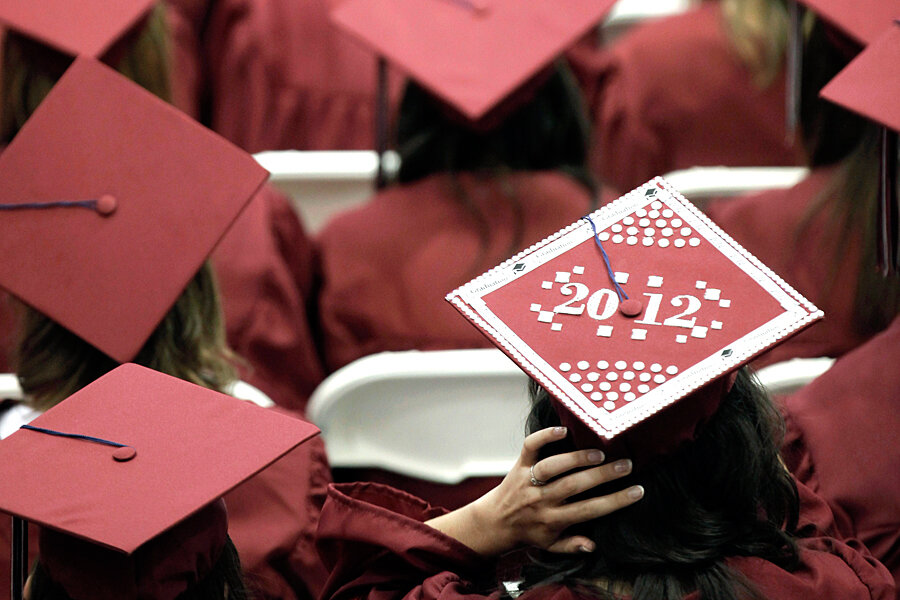US high school graduation rates hit historic high
Loading...
For the first time since such data has been kept, 80 percent of America's high schoolers are graduating in four years, according to new data from the Department of Education.
The progress is incremental. The data are from the 2011-12 school year and represent only a one percentage point increase over the previous year. But the number is significant – as is the way those gains were made, say education experts. Some believe the US graduation rate is on track to hit 90 percent by 2020.
Gains were made by all disadvantaged groups, including low-income students, students of color, students with disabilities, and English language learners – though significant gaps remain for all those groups, and there are large disparities in the graduation rates for different states.
“It’s really significant. After 30 years of flat-lining high school graduation rates and four successive US presidents setting a 90 percent graduation goal, finally over the last decade we’ve seen a 10 percentage point gain,” says John Bridgeland, coauthor of the 2014 Building a Grad Nation report, which was also released Monday.
That steady success in the past decade has meant 1.7 million more high school graduates, and there has been a reduction of nearly 650 so-called “dropout factories” – high schools that graduate fewer than 60 percent of their students, says Mr. Bridgeland, CEO of Civic Enterprises. The most significant progress has come in recent years, when graduating from high school has become more challenging.
But he and others note that there remain daunting challenges – particularly in bringing up the graduation rates for some disadvantaged student populations. Not a single major urban district has crossed the 80 percent threshold yet, says Bridgeland, and some 1,300 dropout factories remain.
“As a country, we owe a debt of gratitude to the teachers, students and families whose hard work has helped us reach an 80 percent high school graduation rate,” said Education Secretary Arne Duncan in a statement Monday morning. “But even as we celebrate this remarkable achievement, our students have limitless potential and we owe it to all of our children to work together so they all can achieve at higher levels.”
The statistics released Monday show progress, albeit slight, on a national level for all subgroups. In 2010-11, for instance, black students had a 67 percent four-year graduation rate, which rose to 69 percent in 2011-12. A number of other subgroups had a similar two point gain: The average graduation rate for Hispanic students rose from 71 to 73 percent; the graduation rate for low-income students rose from 70 to 72 percent; the rate for students with disabilities rose from 59 percent to 61 percent; and the rate for students with limited English proficiency rose from 57 percent to 59 percent.
The rates for individual states, however, vary widely, as do their graduation-rate gaps between various populations. For overall graduation rates, Iowa is the highest, with a rate of 89 percent (up from 88 percent the year before). Nevada trails at the end, with a graduation rate of 63 percent. Only the District of Columbia fared worse, with a rate of 59 percent. Nevada’s graduation rates for students with disabilities or limited English proficiency is particularly abysmal, at 24 percent and 23 percent, respectively.
Montana, on the other hand, does an unusually good job graduating its students with disabilities, with a graduation rate for 2011-12 of 81 percent – well over the national average.
And Tennessee, Arkansas, and Texas all had graduation rates well over the national average for their economically disadvantaged students, despite having relatively high percentages of low-income students in the state.
Such a finding “strongly suggests this is not a chronically unfixable problem of poverty or demography or circumstances of birth, but is about … providing school-based reforms we know will keep young people on track to graduate from high school prepared for college or career,” says Bridgeland.
President Obama has set a goal of reaching a 90 percent graduation rate by 2020 – which is reachable if these gains continue but would require significant improvement in key areas, according to the Building a Grad Nation report. These include low-income students, special-education students, students in big cities, young men of color in key states (particularly in the South and Midwest), and the state of California.
The 2011-12 rates for big urban districts range from 50 percent in Minneapolis to 79 percent in Houston; Columbus, Ohio; and Des Moines, Iowa – all below the national average. California faces particular challenges as America’s most populous state, the state with the highest poverty rate, and as a state with a population that is 61 percent nonwhite. Improvement in California is key to America’s overall graduation rate reaching 90 percent, say the report authors. Its current graduation rate is 78 percent.
A lot has been learned in the past decade, says Bridgeland.
Key, he says, is helping students see the relation between what they’re learning in school and their goals for the future.
Districts that have implemented early-warning systems in middle school to start identifying students most at risk of dropping out – using signs like attendance and grades – have also had success improving graduation rates. Other successful strategies include creating a culture of high expectations, giving students multiple pathways to a degree, and including alternative schools that can meet demands for an unusual schedule.
“We found that dropping out was a slow process of disengagement from school,” says Bridgeland. “What gives me hope are these examples of states and districts and systems that are being redesigned effectively.”
(All rates cited here are the "adjusted cohort graduation rate" or ACGR, which is considered the most precise figure, but which states have only recently started reporting. The Department of Education also released its "averaged freshman graduation rate" for all groups and states, which gives similar, but slightly different, numbers.)








